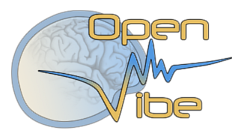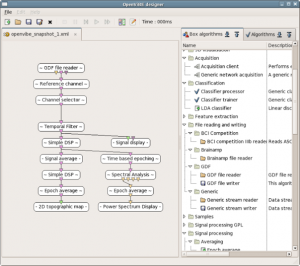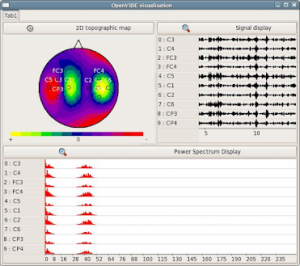
in progress since 2006
Partners: Hybrid, Athena, Neurosys, Potioc
OpenViBE is a free and open-source software platform for the acquisition, processing, classification and display of brain signals (e.g., EEG, MEG, ECoG, …). The platform consist in a set of software modules that can be integrated easily and efficiently, in order to design real-time applications for neuroscience including Brain-Computer Interfaces (BCI) and neurofeedback. It is made to be easy, in the sense that by using OpenViBE, it becomes possible to rapidly create a BCI without writing a single line of code. Indeed, OpenViBE enables users to design a BCI by using only graphical programming, simply by adding and assembling together boxes, each box corresponding to a given processing module (see pictures below)
 Graphical design of a BCI or neurofeedback system using OpenViBE
Graphical design of a BCI or neurofeedback system using OpenViBE
OpenViBE already proposes various features and processing modules in order to design a BCI, such as:
- Processing modules: temporal filters, spatials filters, ICA, windowing, FFT, time-frequency analysis, wavelets, etc.
- Classification modules: linear discriminant analysis, support vector machines, classifier combination, etc.
- Visualization modules: raw signal, 2D topography, 3D topography, spectrums, etc.
- Easy interaction with virtual reality applications
- Acquisition from various EEG devices
- Ready-to-use BCI: motor imagery based BCI (binary of multiclass, synchronous or self-paced), P300-based BCI, SSVEP, neurofeedback, …
 Some modules for real-time visualization of brain activity in OpenViBE
Some modules for real-time visualization of brain activity in OpenViBE
For more details and to download (for free) the OpenViBE platform, you may go there: http://openvibe.inria.fr/
The Potioc team is involved in the design, development and evolution of the OpenViBE software through the following main projects and events:
Projects:
- OpenViBE-NT (2012-2014)
- OpenViBE-X (2014-2016)
Events:
- First OpenViBE workshop as satellite of 6th International Brain-Computer Interface Conference






